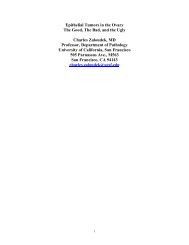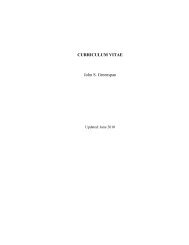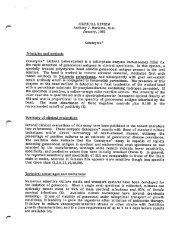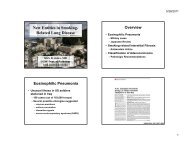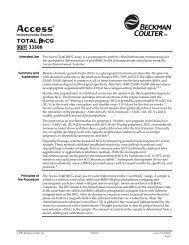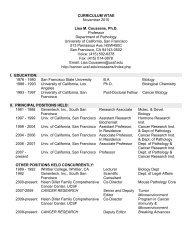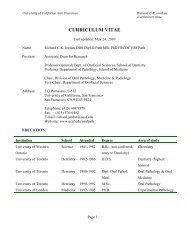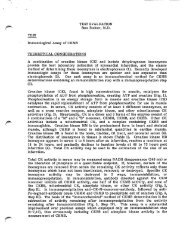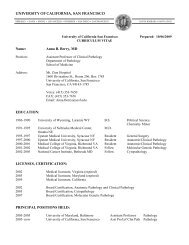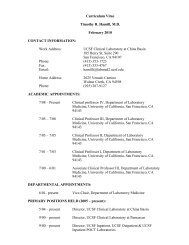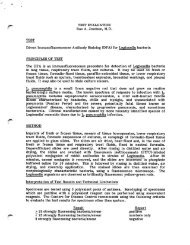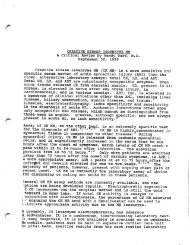Treatment Induced Changes in the Breast: Diagnosis and Staging of ...
Treatment Induced Changes in the Breast: Diagnosis and Staging of ...
Treatment Induced Changes in the Breast: Diagnosis and Staging of ...
Create successful ePaper yourself
Turn your PDF publications into a flip-book with our unique Google optimized e-Paper software.
<strong>Treatment</strong> <strong>Induced</strong> <strong>Changes</strong> <strong>in</strong> <strong>the</strong> <strong>Breast</strong>:<br />
<strong>Diagnosis</strong> <strong>and</strong> Stag<strong>in</strong>g <strong>of</strong> Residual Cancer after Neoadjuvant Chemo<strong>the</strong>rapy<br />
Joseph Rabban MD MPH<br />
Associate Pr<strong>of</strong>essor<br />
UCSF Pathology Department<br />
joseph.rabban@ucsf.edu<br />
June 2010<br />
Introduction: Chemo<strong>the</strong>rapy <strong>and</strong> radiation treatment can cause significant changes <strong>in</strong> <strong>the</strong> gross <strong>and</strong><br />
microscopic appearance <strong>of</strong> benign <strong>and</strong> malignant breast tissue. Because neoadjuvant chemo<strong>the</strong>rapy is<br />
now be<strong>in</strong>g <strong>of</strong>fered to a larger subset <strong>of</strong> breast cancer patients, pathologists are more frequently presented<br />
with breast specimens harbor<strong>in</strong>g such changes. These changes may <strong>in</strong>terfere with recognition <strong>of</strong><br />
microscopic residual tumor, particularly near marg<strong>in</strong>s <strong>and</strong> <strong>in</strong> lymph nodes, estimation <strong>of</strong> residual tumor<br />
size, <strong>and</strong> tumor stag<strong>in</strong>g. This lecture will review <strong>the</strong> spectrum <strong>of</strong> histologic alterations that can be seen <strong>in</strong><br />
benign <strong>and</strong> malignant treated breast tissue <strong>and</strong> implications for gross<strong>in</strong>g, diagnosis <strong>and</strong> stag<strong>in</strong>g.<br />
<strong>Treatment</strong> <strong>Induced</strong> <strong>Changes</strong> <strong>in</strong> <strong>Breast</strong> Tissue<br />
In Benign Tissue<br />
Lobular atrophy<br />
Lobular fibrosis<br />
Epi<strong>the</strong>lial atypia (nucleocytomegaly, hyperchromasia)<br />
Stromal fibrosis<br />
In Malignant Tissue<br />
Reduction <strong>in</strong> tumor bulk/cellularity (residual tumor may be grossly occult)<br />
Reduction <strong>in</strong> cytologic atypia (tumor cells acquire bl<strong>and</strong> nuclear features)<br />
Acquisition <strong>of</strong> foamy/apocr<strong>in</strong>e cytoplasm (tumor cells mimic histiocytes)<br />
Conversion to ductal morphology <strong>of</strong> lobular cancer<br />
Potential Pitfalls <strong>in</strong> Evaluation <strong>of</strong> Treated <strong>Breast</strong> Cancer<br />
Under-recognition <strong>of</strong> residual tumor (false diagnosis <strong>of</strong> “no residual tumor”)<br />
Under-estimate <strong>of</strong> residual tumor size<br />
Under-recognition <strong>of</strong> positive marg<strong>in</strong> <strong>in</strong>volvement<br />
Under-recognition <strong>of</strong> nodal <strong>in</strong>volvement<br />
Misclassification <strong>of</strong> ductal carc<strong>in</strong>oma as lobular carc<strong>in</strong>oma<br />
Under-stag<strong>in</strong>g<br />
Over-diagnosis <strong>of</strong> treatment <strong>in</strong>duced atypia <strong>in</strong> benign epi<strong>the</strong>lium<br />
Neoadjuvant Chemo<strong>the</strong>rapy (NACT) Effects on <strong>the</strong> <strong>Breast</strong><br />
C<strong>and</strong>idates for NACT: Pre-operative chemo<strong>the</strong>rapy (also known as primary <strong>the</strong>rapy or neoadjuvant<br />
chemo<strong>the</strong>rapy, NACT) was <strong>in</strong>itially <strong>in</strong>troduced for manag<strong>in</strong>g patients with locally advanced breast cancer<br />
<strong>and</strong> is now considered st<strong>and</strong>ard <strong>of</strong> care for such patients. NACT is now also be<strong>in</strong>g selectively <strong>of</strong>fered to<br />
certa<strong>in</strong> patients with large but operable breast cancer. Among patients with locally advanced cancer, <strong>the</strong><br />
goal <strong>of</strong> NACT is to improve operability, to enhance local control, <strong>and</strong> to convert some patients from<br />
mastectomy to breast conserv<strong>in</strong>g <strong>the</strong>rapy (also called “downstag<strong>in</strong>g”). The same goals apply to patients<br />
with large but operable cancer. Additionally, by determ<strong>in</strong><strong>in</strong>g response to <strong>the</strong>rapy (i.e. tumor shr<strong>in</strong>kage),<br />
one can potentially tailor future chemo<strong>the</strong>rapy decisions for a given patient.<br />
In <strong>the</strong> h<strong>and</strong>ful <strong>of</strong> r<strong>and</strong>omized cl<strong>in</strong>ical trials to date, overall survival <strong>and</strong> disease free survival are <strong>the</strong> same<br />
<strong>in</strong> patients receiv<strong>in</strong>g NACT versus adjuvant chemo<strong>the</strong>rapy. The advantages are that; more patients are<br />
able to undergo breast conserv<strong>in</strong>g surgery <strong>and</strong> more patients are found to be axillary node negative.<br />
Patients who have no pathologic evidence <strong>of</strong> residual tumor follow<strong>in</strong>g NACT do have better disease-free<br />
survival <strong>and</strong> overall survival; this occurs <strong>in</strong> 6% to 19% <strong>of</strong> patients treated with NACT.
The key tasks <strong>in</strong> evaluat<strong>in</strong>g <strong>the</strong> breast excision specimen (lumpectomy or mastectomy) follow<strong>in</strong>g NACT<br />
are:<br />
-determ<strong>in</strong><strong>in</strong>g residual tumor size<br />
-dist<strong>in</strong>guish<strong>in</strong>g treatment effect on benign breast from tumor<br />
-detect<strong>in</strong>g nodal metastases <strong>in</strong> <strong>the</strong> presence <strong>of</strong> treatment effect<br />
-evaluat<strong>in</strong>g marg<strong>in</strong> status for occult s<strong>in</strong>gle tumor cells<br />
Def<strong>in</strong><strong>in</strong>g Response to Chemo<strong>the</strong>rapy<br />
The World Health Organization <strong>and</strong> International Union Aga<strong>in</strong>st Cancer have def<strong>in</strong>ed criteria for<br />
evaluat<strong>in</strong>g response to systemic <strong>the</strong>rapy <strong>in</strong> general:<br />
Complete response (CR): complete absence <strong>of</strong> detectable disease<br />
Partial response (PR): >50% reduction <strong>in</strong> maximal dimension <strong>of</strong> tumor<br />
Progressive disease (PD): <strong>in</strong>crease <strong>in</strong> tumor size by more than 25%<br />
Stable disease (SD): no <strong>in</strong>crease <strong>in</strong> tumor size more than 25%<br />
No response (NR): scenarios that do not fulfill any <strong>of</strong> <strong>the</strong> above criteria<br />
Response can be evaluated cl<strong>in</strong>ically, <strong>in</strong> which case <strong>the</strong> nomenclature is prefixed by <strong>the</strong> letter “c”. For<br />
example, cCR <strong>in</strong>dicates a complete disappearance <strong>of</strong> tumor by cl<strong>in</strong>ical exam. Response can also be<br />
evaluated pathologically at time <strong>of</strong> surgery. For example, pCR <strong>in</strong>dicates that no residual tumor is found <strong>in</strong><br />
<strong>the</strong> specimen. pPR <strong>in</strong>dicates that <strong>the</strong> residual tumor found <strong>in</strong> <strong>the</strong> specimen is more than 50% smaller<br />
than <strong>the</strong> pre-treatment size. This nomenclature is predom<strong>in</strong>antly used cl<strong>in</strong>ically. As long as <strong>the</strong> residual<br />
tumor size (or its absence) is <strong>in</strong>dicated <strong>in</strong> surgical pathology reports, <strong>the</strong> pathologist need not <strong>in</strong>corporate<br />
this vocabulary <strong>in</strong>to <strong>the</strong> pathology report.<br />
Efficacy <strong>of</strong> NACT<br />
The NSABP-B18 trial is one <strong>of</strong> <strong>the</strong> largest prospective r<strong>and</strong>omized trials to evaluate NACT <strong>in</strong> breast<br />
cancer. 608 patients were r<strong>and</strong>omized to receive a pre-operative course <strong>of</strong> four cycles <strong>of</strong> AC<br />
(doxorubic<strong>in</strong> <strong>and</strong> cyclophosphamide) <strong>and</strong> 626 patients were r<strong>and</strong>omized to receive post-operative<br />
treatment by <strong>the</strong> same chemo<strong>the</strong>rapy. Patients were followed for 9 years. Overall, 80% <strong>of</strong> tumors<br />
showed at least a cl<strong>in</strong>ical partial response <strong>and</strong> cl<strong>in</strong>ical complete response <strong>in</strong> 36%; among <strong>the</strong>se with cCR,<br />
38% had pCR. 13% had both cCR <strong>and</strong> pCR while 7% had pCR without cCR. Lymph node metastases<br />
were also fewer <strong>in</strong> <strong>the</strong> NACT group compared to st<strong>and</strong>ard post-operative adjuvant treatment. From a<br />
cl<strong>in</strong>ical management perspective, more patients were able to undergo lumpectomy follow<strong>in</strong>g NACT, a<br />
benefit that extended to patients whose tumors were <strong>in</strong>itially cl<strong>in</strong>ically measured >5 cm. Overall survival<br />
<strong>and</strong> disease free survival was no different, however, between pre <strong>and</strong> post-operatively treated patients.<br />
Among neoadjuvant treated patients, better overall survival <strong>and</strong> disease free survival occurred <strong>in</strong> those<br />
with both a cl<strong>in</strong>ical <strong>and</strong> pathologic complete response. Poor nuclear grade <strong>in</strong> pre-treatment biopsy was<br />
associated with pCR (26% achieve pCR) versus good nuclear grade (14%). A recent meta-analysis <strong>of</strong><br />
<strong>the</strong> h<strong>and</strong>ful <strong>of</strong> well-designed cl<strong>in</strong>ical trials confirmed this f<strong>in</strong>d<strong>in</strong>g that overall survival is <strong>the</strong> same as<br />
st<strong>and</strong>ard adjuvant <strong>the</strong>rapy. The ma<strong>in</strong> benefit is conversion to breast conservation <strong>in</strong> a subset <strong>of</strong> patients<br />
as well as identify<strong>in</strong>g non-responders to chemo<strong>the</strong>rapy.<br />
Gross Pathologic <strong>Changes</strong> Follow<strong>in</strong>g NACT<br />
Stromal fibrosis <strong>and</strong> a wound-heal<strong>in</strong>g type <strong>of</strong> response are common changes <strong>in</strong> breast tumors that<br />
respond to NACT. This can sometimes, but not always be appreciated grossly.<br />
If a pathologic complete response occurs, <strong>the</strong> gross appearance may be ei<strong>the</strong>r unremarkable or fibrotic<br />
at <strong>the</strong> site <strong>of</strong> <strong>the</strong> orig<strong>in</strong>al tumor bed. If microscopic residual tumor exists, <strong>the</strong>re might not be any gross<br />
f<strong>in</strong>d<strong>in</strong>g o<strong>the</strong>r than fibrosis. We have encountered cases <strong>of</strong> apparent complete cl<strong>in</strong>ical response <strong>in</strong> which<br />
<strong>the</strong>re no gross f<strong>in</strong>d<strong>in</strong>gs but occult tumor cells were widely scattered throughout <strong>the</strong> breast.
Sampl<strong>in</strong>g Recommendations for NACT breast specimens<br />
Gross estimation <strong>of</strong> residual tumor size can be mislead<strong>in</strong>g because <strong>of</strong> stromal fibrosis. Both<br />
overestimates <strong>and</strong> underestimates <strong>of</strong> residual tumor size can occur, <strong>the</strong>refore, careful correlation with<br />
f<strong>in</strong>d<strong>in</strong>gs on histologic slides is important. Reconstruction <strong>of</strong> tumor size based on slide f<strong>in</strong>d<strong>in</strong>gs is more<br />
accurate <strong>in</strong> our experience (see below).<br />
It is important to know <strong>the</strong> pre-chemo<strong>the</strong>rapy estimate <strong>of</strong> tumor size. Tissue from across at least that<br />
dimension should be sampled from <strong>the</strong> mastectomy regardless <strong>of</strong> whe<strong>the</strong>r gross pathology is present or<br />
not. For example, if <strong>the</strong> pre-chemo<strong>the</strong>rapy tumor was 5 cm but <strong>the</strong> gross residual tumor is 2 cm, tissue<br />
should be sampled from at least 5 cm surround<strong>in</strong>g <strong>the</strong> center <strong>of</strong> <strong>the</strong> residual mass. In fact, because<br />
cl<strong>in</strong>ical/radiologic size estimates can be under-estimates, we would extend <strong>the</strong> sampl<strong>in</strong>g to beyond a 5<br />
cm size just <strong>in</strong> case microscopic tumor was present beyond <strong>the</strong> cl<strong>in</strong>ically estimated boundaries. Heavy<br />
sampl<strong>in</strong>g <strong>of</strong> marg<strong>in</strong>s is also advised, regardless <strong>of</strong> whe<strong>the</strong>r <strong>the</strong> gross appearance is suspicious or not.<br />
Measur<strong>in</strong>g Residual Tumor Follow<strong>in</strong>g NACT<br />
Tumors do not necessarily shr<strong>in</strong>k concentrically from <strong>the</strong> outside <strong>in</strong>wardly or vice versa; tumor regression<br />
can be patchy <strong>and</strong> irregular. Residual tumor may be present <strong>in</strong> one <strong>of</strong> several patterns:<br />
A dom<strong>in</strong>ant mass (usually grossly visible)<br />
Scattered nodules amongst altered stroma (usually grossly visible)<br />
Occult microscopic foci scattered amongst altered stroma (not grossly visible)<br />
Rare scattered s<strong>in</strong>gle cells (not grossly visible.<br />
This variability causes difficulty not only <strong>in</strong> measur<strong>in</strong>g residual tumor size, but also <strong>in</strong> miss<strong>in</strong>g occult tumor<br />
cells.<br />
Until <strong>the</strong> recent 7 th edition <strong>of</strong> <strong>the</strong> AJCC Stag<strong>in</strong>g System, <strong>the</strong>re were no st<strong>and</strong>ardized methods <strong>of</strong><br />
pathologically measur<strong>in</strong>g residual tumor follow<strong>in</strong>g NACT. It is not a straightforward task because <strong>of</strong> <strong>the</strong><br />
various distribution patterns that can be seen. Rely<strong>in</strong>g on radiologic size is not always accurate. Both<br />
under <strong>and</strong> overestimation can occur. For example, if a 5 cm radiologic mass is reduced to a<br />
hyal<strong>in</strong>ized, relatively acellular tumor bed which conta<strong>in</strong>s two microscopic foci <strong>of</strong> occult tumor cell clusters<br />
measur<strong>in</strong>g 0.2 cm each but separated by 3 cm, how should residual tumor size be <strong>in</strong>terpreted. Is this a 3<br />
cm tumor? Or is this microscopic residual tumor foci, measur<strong>in</strong>g up to 0.2 cm each? (an <strong>in</strong>terpretation<br />
that could be substantiated if <strong>the</strong> <strong>in</strong>terven<strong>in</strong>g 3 cm conta<strong>in</strong>s normal proliferative changes without any<br />
evidence <strong>of</strong> stromal changes <strong>of</strong> tumor regression). The cl<strong>in</strong>ical significance <strong>of</strong> <strong>the</strong> difference <strong>in</strong> <strong>the</strong>se<br />
<strong>in</strong>terpretations is unknown.<br />
AJCC Def<strong>in</strong>ition <strong>of</strong> residual tumor size: AJCC now states that <strong>the</strong> s<strong>in</strong>gle largest mass <strong>of</strong> residual <strong>in</strong>vasive<br />
cancer should be measured <strong>and</strong> used for ypT stag<strong>in</strong>g. The background fibrotic tumor bed (granulation<br />
tissue, fibrosis, organiz<strong>in</strong>g hemorrhage) should not be counted. If <strong>the</strong>re are scattered nests <strong>of</strong> tumor cells<br />
ra<strong>the</strong>r than a “mass”, AJCC states that <strong>the</strong> “largest contiguous area <strong>of</strong> <strong>in</strong>vasive carc<strong>in</strong>oma” should be<br />
measured.<br />
Recommendation: We follow <strong>the</strong> new AJCC rules, however <strong>in</strong> many scenarios it is not clear how to apply<br />
<strong>the</strong>m.<br />
Scenario 1: If <strong>the</strong>re are multiple discrete foci <strong>of</strong> residual <strong>in</strong>vasive cancer, we base AJCC ypT on <strong>the</strong><br />
largest discrete focus, but we also document <strong>in</strong> our report <strong>the</strong> total span <strong>of</strong> all <strong>in</strong>vasive foci.<br />
Scenario 2: If <strong>the</strong>re is residual <strong>in</strong>vasive cancer but <strong>in</strong>stead <strong>of</strong> a discrete focus it is present as microscopic<br />
cells or clusters distributed <strong>in</strong> a low cellularity across a large span, we base AJCC ypT on <strong>the</strong> total span <strong>of</strong><br />
<strong>the</strong> <strong>in</strong>vasive cancer. We also give a subjective description <strong>of</strong> <strong>the</strong> cellularity (i.e. scant cellularity, low<br />
cellularity, high cellularity) to dist<strong>in</strong>guish a 4 cm focus <strong>of</strong> highly cellular residual cancer from a 4 cm focus<br />
<strong>of</strong> scant residual cancer cells embedded <strong>in</strong> organiz<strong>in</strong>g fibrosis.
Histologic <strong>Changes</strong> Follow<strong>in</strong>g NACT<br />
<strong>Changes</strong> can be seen <strong>in</strong> <strong>the</strong> tumor architecture <strong>and</strong> cytology, <strong>the</strong> stroma, <strong>and</strong> <strong>the</strong> architecture <strong>of</strong> <strong>the</strong><br />
term<strong>in</strong>al duct lobular unit (TDLU).<br />
In Benign Tissue<br />
Lobular atrophy<br />
Lobular fibrosis<br />
Epi<strong>the</strong>lial atypia (nucleocytomegaly, hyperchromasia)<br />
Stromal fibrosis<br />
In Malignant Tissue<br />
Reduction <strong>in</strong> tumor bulk/cellularity (residual tumor may be grossly occult)<br />
Reduction <strong>in</strong> cytologic atypia (tumor cells acquire bl<strong>and</strong> nuclear features)<br />
Acquisition <strong>of</strong> foamy/apocr<strong>in</strong>e cytoplasm (tumor cells mimic histiocytes)<br />
Acquisition <strong>of</strong> lobular “morphology” <strong>in</strong> ductal carc<strong>in</strong>oma<br />
Histiocytoid changes:<br />
Cytoplasmic eos<strong>in</strong>ophilia, dense or glassy cytoplasm, <strong>and</strong> rounded tumor cell shape can occur, <strong>of</strong>ten<br />
result<strong>in</strong>g <strong>in</strong> a histiocyte-like appearance. Rare, scattered s<strong>in</strong>gle tumor cells with such changes can be<br />
difficult to dist<strong>in</strong>guish from histiocytes. The presence <strong>of</strong> nuclear atypia or mitoses is helpful; <strong>in</strong> some<br />
cases, when a marg<strong>in</strong> is <strong>in</strong>volved, kerat<strong>in</strong> immunohistochemistry may be useful. Cluster<strong>in</strong>g <strong>of</strong> a few tumor<br />
cells toge<strong>the</strong>r to form a small tight ball may give a mult<strong>in</strong>ucleated appearance that also can mimic<br />
histiocytes. Cl<strong>in</strong>ical significance <strong>of</strong> <strong>the</strong>se changes is unknown. The importance is to be aware <strong>of</strong> occult<br />
tumor cells mimick<strong>in</strong>g histiocytes near surgical marg<strong>in</strong>s.<br />
Treated tumor cell<br />
Feature mimick<strong>in</strong>g histiocytes Histiocyte<br />
Size larger than histiocyte small<br />
Cytoplasmic contents muc<strong>in</strong>, large vacuoles hemosider<strong>in</strong><br />
Nuclear pleomorphism present absent<br />
Mult<strong>in</strong>ucleation can be present usually absent<br />
Hyperchromasia present absent<br />
Mitoses can be present absent<br />
Kerat<strong>in</strong> sta<strong>in</strong><strong>in</strong>g positive negative<br />
Cytoplasmic vacuolation <strong>of</strong> tumor cells:<br />
Optically clear cytoplasmic vacuoles sometimes may be seen <strong>in</strong> tumor cells. Rarely, it is possible to<br />
mistake cells with prom<strong>in</strong>ent clear vacuoles as myoepi<strong>the</strong>lium. When such tumor cells are arranged <strong>in</strong><br />
small gl<strong>and</strong>ular or tubular architecture <strong>and</strong> display m<strong>in</strong>imal atypia, it is possible to mistake <strong>the</strong> tumor for<br />
benign breast epi<strong>the</strong>lium. We have even encountered rare cases <strong>of</strong> mimicry <strong>in</strong> which residual tumor cells<br />
are distributed <strong>in</strong> scleros<strong>in</strong>g adenosis-like pattern <strong>and</strong> also have cytoplasmic vacuoles. Such appearance<br />
can easily be mis<strong>in</strong>terpreted as benign proliferative disease. When diagnostic doubt is raised,<br />
immunohistochemical myoid markers can dist<strong>in</strong>guish vacuolated tumor cells from myoepi<strong>the</strong>lial cells.
Recommendation: If <strong>the</strong> pre-treatment tumor was HER2 positive by immunohistochemistry, HER2 can be<br />
used to dist<strong>in</strong>guish residual treated tumor cells from benign mimics (histiocytes, normal epi<strong>the</strong>lium). This<br />
is especially useful when evaluat<strong>in</strong>g marg<strong>in</strong>s or cells with crush artifact.<br />
Evaluat<strong>in</strong>g tumor type follow<strong>in</strong>g NACT<br />
Because <strong>of</strong> <strong>the</strong> cumulative changes to <strong>the</strong> cytoplasm, nuclei, architecture, <strong>and</strong> distribution <strong>of</strong> residual<br />
tumor cells follow<strong>in</strong>g NACT, it may be difficult to assess histologic tumor type. The pre-treatment breast<br />
biopsy is <strong>the</strong> most <strong>in</strong>formative specimen for assess<strong>in</strong>g tumor type. The histiocytoid changes to tumor<br />
cells <strong>and</strong> <strong>the</strong> isolated s<strong>in</strong>gle cell distribution pattern, for example, <strong>in</strong> some residual tumors may mimic<br />
lobular or even pleomorphic lobular differentiation even though <strong>the</strong> pre-treatment core biopsy shows clear<br />
cut ductal differentiation. In <strong>the</strong> NSABP B18 trial, most <strong>of</strong> <strong>the</strong> cases were classified as carc<strong>in</strong>oma NOS<br />
follow<strong>in</strong>g NACT.<br />
Recommendation: Compar<strong>in</strong>g <strong>the</strong> histologic subtype <strong>of</strong> <strong>the</strong> pre-treatment tumor to <strong>the</strong> post-treatment<br />
tumor is good practice, s<strong>in</strong>ce <strong>the</strong> two should be concordant. If <strong>the</strong> post-treatment tumor shows lobular<br />
differentiation, but <strong>the</strong> pre-treatment tumor is ductal, <strong>the</strong> change may be an artifact <strong>of</strong> treatment ra<strong>the</strong>r<br />
than real. E-cadher<strong>in</strong>/p120 immunohistochemistry is advised if <strong>the</strong>re is a discrepancy.<br />
Grad<strong>in</strong>g residual tumor follow<strong>in</strong>g NACT<br />
Because <strong>of</strong> <strong>the</strong> potential cytologic <strong>and</strong> architectural changes <strong>in</strong> tumor follow<strong>in</strong>g NACT, it is reasonable to<br />
raise several questions about traditional tumor grad<strong>in</strong>g if applied to <strong>the</strong> residual tumor:<br />
1.) does NACT cause a significant change before <strong>and</strong> after treatment?<br />
2.) is <strong>the</strong> post treatment grade cl<strong>in</strong>ically valuable (i.e. does it predict survival)?<br />
3.) should a grade be <strong>in</strong>cluded formally <strong>in</strong> <strong>the</strong> surgical pathology report.<br />
Available data with which to address <strong>the</strong>se questions is limited. Frierson et al showed <strong>in</strong> a small study<br />
that pre <strong>and</strong> post treatment grades did not significantly differ but Sharkey et al found changes <strong>in</strong> about a<br />
third <strong>of</strong> patients. Both studies had small numbers <strong>of</strong> patients. Chollet et al tested Scarff-Bloom-<br />
Richardson grad<strong>in</strong>g as well as various comb<strong>in</strong>ations <strong>of</strong> grade with tumor size <strong>and</strong> lymph node status <strong>in</strong><br />
post-treatment specimens; none <strong>of</strong> <strong>the</strong> variables showed any statistically significant relationship with<br />
overall survival, though disease-free survival was related to lymph node status <strong>and</strong> a modified<br />
comb<strong>in</strong>ation <strong>of</strong> tumor size + grade. The best responders to NACT are those with poorly differentiated<br />
tumors where as <strong>the</strong> low grade tumors tend not to respond as well to NACT. This may confound <strong>the</strong><br />
results when look<strong>in</strong>g at outcome <strong>of</strong> post-treatment grad<strong>in</strong>g. Larger scale studies are required with long<br />
follow up.<br />
Recommendation: Our current practice is to note that traditional SBR grad<strong>in</strong>g may not carry <strong>the</strong> same<br />
cl<strong>in</strong>ical significance <strong>in</strong> <strong>the</strong> NACT patient; with this caveat, we do provide a post-treatment tumor grade.<br />
Surgical marg<strong>in</strong> evaluation follow<strong>in</strong>g NACT<br />
Evaluat<strong>in</strong>g marg<strong>in</strong>s can be treacherous because s<strong>in</strong>gle histiocytoid tumor cells may not be seen at low<br />
power. Occult tumor cells are likely to be hidden <strong>in</strong> granulation type tissue, a key visual clue at low<br />
power. The extent <strong>of</strong> occult tumor that is underestimated can be easily appreciated on a kerat<strong>in</strong> sta<strong>in</strong>.<br />
HER2 immunosta<strong>in</strong><strong>in</strong>g is ano<strong>the</strong>r option if <strong>the</strong> pre-treatment tumor was HER2 positive.<br />
Hormone receptor status follow<strong>in</strong>g NACT<br />
Status <strong>of</strong> estrogen receptor (ER), progesterone receptor (PR), <strong>and</strong> Her2/neu is best determ<strong>in</strong>ed on <strong>the</strong><br />
surgical biopsy obta<strong>in</strong>ed prior to NACT because <strong>the</strong> mastectomy/lumpectomy specimen may not conta<strong>in</strong><br />
any or sufficient residual tumor for test<strong>in</strong>g. The status <strong>of</strong> <strong>the</strong>se biomarkers may be altered follow<strong>in</strong>g a<br />
course <strong>of</strong> NACT but is usually concordant with pre-treatment status. The literature conta<strong>in</strong>s only few<br />
studies <strong>of</strong> pre <strong>and</strong> post NACT comparison <strong>of</strong> biomarker status. For ER <strong>and</strong> PR status, studies have<br />
reported changes <strong>in</strong> around 10% <strong>of</strong> cases but some studies document changes <strong>in</strong> up to a third <strong>of</strong> cases;<br />
most commonly, ER status changes from positive to negative. Her2 status appears to be more stable<br />
throughout NACT. Concordance between pre <strong>and</strong> post NACT Her2 status ranges from 65% to 100%.
FISH test<strong>in</strong>g appears more stable than immunohistochemical test<strong>in</strong>g for Her2, with concordance <strong>of</strong> 87%<br />
<strong>and</strong> higher reported.<br />
<strong>Changes</strong> <strong>in</strong> Benign <strong>Breast</strong> follow<strong>in</strong>g NACT<br />
Term<strong>in</strong>al Duct-Lobular Unit (TDLU) sclerosis / atrophy<br />
Sclerosis <strong>of</strong> <strong>the</strong> non-tumorous TDLU basement membrane can be extensive <strong>and</strong> <strong>the</strong> appearance may<br />
mimic age-related atrophic changes. TDLU sclerosis can be patchy <strong>and</strong> focal throughout <strong>the</strong> specimen.<br />
About two-thirds <strong>of</strong> neoadjuvant treated patients will exhibit some degree <strong>of</strong> TDLU sclerosis as will about<br />
half <strong>of</strong> adjuvant treated patients. This change can <strong>of</strong>ten be a clue that <strong>the</strong> patient has received NACT <strong>and</strong><br />
is helpful to know about because <strong>the</strong> cl<strong>in</strong>ical history <strong>of</strong> NACT may not always be available to <strong>the</strong><br />
pathologist at <strong>the</strong> time <strong>of</strong> slide review. In particular, <strong>the</strong> f<strong>in</strong>d<strong>in</strong>g <strong>of</strong> TDLU sclerosis <strong>in</strong> a premenopausal<br />
patient should raise <strong>the</strong> possibility <strong>of</strong> NACT.<br />
TDLU epi<strong>the</strong>lial atypia<br />
<strong>Changes</strong> <strong>in</strong> <strong>the</strong> epi<strong>the</strong>lium <strong>of</strong> non-neoplastic TDLU ac<strong>in</strong>i follow<strong>in</strong>g NACT can result <strong>in</strong> nuclear pyknosis or<br />
nuclear atypia. Aga<strong>in</strong>, <strong>the</strong>se changes are nei<strong>the</strong>r common nor evenly distributed with<strong>in</strong> a particular<br />
specimen (i.e. changes can be focal or patchy). Nuclear atypia is usually accompanied by overall<br />
enlarged cells (nucleocytomegaly). These changes are not as well reported <strong>in</strong> <strong>the</strong> literature as those<br />
follow<strong>in</strong>g radiation treatment.<br />
Inflammation / duct ectasia<br />
Vary<strong>in</strong>g degrees <strong>of</strong> duct ectasia <strong>in</strong>volv<strong>in</strong>g <strong>the</strong> benign breast may be evident. The ducts may be dilated<br />
<strong>and</strong> conta<strong>in</strong> a mixture <strong>of</strong> histiocytes <strong>and</strong> prote<strong>in</strong>aceous debris. Histiocytes may be concentrically<br />
aggregated around <strong>the</strong> duct wall with vary<strong>in</strong>g amounts <strong>of</strong> chronic <strong>in</strong>flammatory <strong>in</strong>filtrates. Some<br />
specimens conta<strong>in</strong> prom<strong>in</strong>ent b<strong>and</strong>s <strong>of</strong> chronic <strong>in</strong>flammation surround<strong>in</strong>g ducts <strong>and</strong> TDLUs. These<br />
changes are not necessarily present near sites <strong>of</strong> residual tumor or orig<strong>in</strong>al tumor bed. Larger<br />
aggregates <strong>of</strong> histiocytes with<strong>in</strong> fibrotic stroma, <strong>of</strong>ten near sites <strong>of</strong> residual tumor can be seen. These<br />
aggregates may span several millimeters <strong>and</strong> are presumably sites that once conta<strong>in</strong>ed tumor cells.<br />
Axillary lymph node changes follow<strong>in</strong>g NACT<br />
Stromal fibrosis may be seen with<strong>in</strong> axillary lymph nodes follow<strong>in</strong>g NACT. Usually this occurs <strong>in</strong> nodes<br />
conta<strong>in</strong><strong>in</strong>g metastatic tumor (75% <strong>of</strong> positive nodes had a stromal response <strong>in</strong> <strong>the</strong> NSABP B18 study) <strong>and</strong><br />
<strong>the</strong> fibrosis surrounds <strong>the</strong> metastatic tumor cells. Nodal fibrosis can be used as a visual clue to <strong>the</strong><br />
presence <strong>of</strong> metastasis but it certa<strong>in</strong>ly can occur <strong>in</strong> <strong>the</strong> absence <strong>of</strong> metastatic cells (12% <strong>of</strong> cases <strong>in</strong> <strong>the</strong><br />
NSABP B18 study); <strong>the</strong> cl<strong>in</strong>ical significance <strong>of</strong> this is unknown.<br />
The 7 th edition AJCC states that post-treatment lymph nodes should be ypN staged us<strong>in</strong>g <strong>the</strong> same<br />
criteria as <strong>in</strong> a non-treated patient. Thus, it is possible for residual small clusters <strong>of</strong> tumor cells to be<br />
present but, if <strong>the</strong> clusters are smaller than 200 <strong>in</strong> number or smaller than 0.2 millimeter, <strong>the</strong> node is<br />
staged as ypN0i+. The one caveat is that AJCC advises that any fibrotic stroma accompany<strong>in</strong>g <strong>the</strong> tumor<br />
cells should be <strong>in</strong>corporated <strong>in</strong>to <strong>the</strong> measurement. Thus, a 0.4 millimeter fibrotic deposit conta<strong>in</strong><strong>in</strong>g a<br />
few isolated tumor cells will be ypN1.<br />
Scope <strong>of</strong> <strong>the</strong> Issue<br />
Radiation <strong>Treatment</strong> Effects <strong>in</strong> <strong>the</strong> <strong>Breast</strong><br />
<strong>Breast</strong> conservation <strong>the</strong>rapy (BCT) is now considered st<strong>and</strong>ard <strong>of</strong> care for early stage primary breast<br />
cancer. The National Cancer Institute position on BCT is based on multiple long term r<strong>and</strong>omized cl<strong>in</strong>ical
trials demonstrat<strong>in</strong>g similar overall survival <strong>in</strong> early stage patients treated by lumpectomy plus radiation<br />
versus mastectomy. The role <strong>of</strong> radiation <strong>in</strong> BCT is to improve local-regional control (reduce localregional<br />
recurrence).<br />
Recurrence follow<strong>in</strong>g BCT ranges from 5% to 22%. Most recurrences are detected with<strong>in</strong> 2 years by post<br />
treatment surveillance mammography, however, a number <strong>of</strong> o<strong>the</strong>r etiologies can produce abnormal<br />
mammograms or palpable lumps post-treatment. Approximately 10% <strong>of</strong> BCT patients will develop a new<br />
mass, new calcifications, or an abnormal mammogram that requires biopsy. About half <strong>of</strong> <strong>the</strong>se lesions<br />
are recurrent tumor; <strong>the</strong> o<strong>the</strong>r half are benign f<strong>in</strong>d<strong>in</strong>gs <strong>in</strong>clud<strong>in</strong>g fat necrosis or scar. Any <strong>of</strong> <strong>the</strong>se<br />
biopsies may harbor radiation <strong>in</strong>duced changes <strong>in</strong> <strong>the</strong> breast epi<strong>the</strong>lium, regardless <strong>of</strong> benign or<br />
malignant status. These radiation-<strong>in</strong>duced changes can be mis<strong>in</strong>terpreted as atypia or malignancy.<br />
Dist<strong>in</strong>guish<strong>in</strong>g benign lesions from recurrent tumor <strong>in</strong> <strong>the</strong> sett<strong>in</strong>g <strong>of</strong> radiation effect may be challeng<strong>in</strong>g –<br />
or impossible <strong>in</strong> rare cases—but a few features help guide <strong>the</strong> dist<strong>in</strong>ction.<br />
Radiation-<strong>in</strong>duced changes <strong>in</strong> benign breast<br />
Both <strong>the</strong> architecture (term<strong>in</strong>al duct-lobular unit, TDLU) <strong>and</strong> <strong>the</strong> cytology <strong>of</strong> <strong>the</strong> normal breast can be<br />
altered by radiation. The predom<strong>in</strong>ant changes occur at <strong>the</strong> level <strong>of</strong> <strong>the</strong> TDLU. Most notable at low<br />
power is an atrophic appearance <strong>of</strong> <strong>the</strong> TDLU. The basement membrane surround<strong>in</strong>g <strong>the</strong> ac<strong>in</strong>i is<br />
thickened <strong>and</strong> hyal<strong>in</strong>ized/collagenized as is <strong>the</strong> <strong>in</strong>tralobular stroma. The ac<strong>in</strong>ar epi<strong>the</strong>lium appears<br />
atrophic; <strong>the</strong> cells are fewer <strong>in</strong> number per ac<strong>in</strong>i <strong>and</strong> smaller <strong>in</strong> size. These features resemble postmenopausal<br />
lobular atrophy. At high power, cytologic atypia can be seen <strong>in</strong> <strong>the</strong> ac<strong>in</strong>ar epi<strong>the</strong>lium:<br />
enlarged hyperchromatic nuclei, small nucleoli, eos<strong>in</strong>ophilic cytoplasm, or f<strong>in</strong>ely vacuolated cytoplasm.<br />
Atypia can also affect <strong>the</strong> larger ducts. Importantly, <strong>the</strong> cytologic atypia is not accompanied by any<br />
evidence <strong>of</strong> loss <strong>of</strong> polarity, proliferation, mitoses or necrosis. In addition to epi<strong>the</strong>lial changes, <strong>the</strong><br />
myoepi<strong>the</strong>lial layer may become quite pronounced, with clear cytoplasm. Stromal changes may be<br />
appreciated. Nuclear enlargement, nuclear atypia, stellate or irregular nuclear contours <strong>and</strong> prom<strong>in</strong>ent<br />
nucleoli, can be seen <strong>in</strong> stromal fibroblasts. Vascular changes are not common; <strong>in</strong> Schnitt’s study only<br />
one quarter <strong>of</strong> specimens were affected. They noted vascular f<strong>in</strong>d<strong>in</strong>gs <strong>of</strong> myo<strong>in</strong>timal proliferation, mural<br />
hyal<strong>in</strong>ization <strong>and</strong> prom<strong>in</strong>ent capillary endo<strong>the</strong>lial cells.<br />
Architectural changes <strong>in</strong> TDLU<br />
-atrophic TDLU (small size, fewer ac<strong>in</strong>ar epi<strong>the</strong>lium)<br />
-thick, hyal<strong>in</strong>ized TDLU basement membrane<br />
-hyal<strong>in</strong>ized <strong>in</strong>tralobular stroma<br />
Cytologic changes <strong>in</strong> TDLU<br />
-enlarged hyperchromatic nuclei<br />
-prom<strong>in</strong>ent nucleoli<br />
-eos<strong>in</strong>ophilic cytoplasm<br />
-f<strong>in</strong>ely vacuolated cytoplasm<br />
-prom<strong>in</strong>ent myoepi<strong>the</strong>lium (abundant clear cytoplasm)<br />
This constellation <strong>of</strong> changes does not equally affect all radiated patients; <strong>in</strong> Schnitt et al’s study, about<br />
30% <strong>of</strong> patients showed mild changes <strong>and</strong> <strong>the</strong> rema<strong>in</strong>der showed more strik<strong>in</strong>g changes. The extent <strong>and</strong><br />
degree <strong>of</strong> changes can be variable with<strong>in</strong> a given specimen. For example, some TDLU could harbor only<br />
a few atypical cells while o<strong>the</strong>rs may be completely <strong>in</strong>volved by atypia. F<strong>in</strong>ally, <strong>the</strong> extent/degree <strong>of</strong><br />
changes do not appear related to <strong>the</strong> radiation dosage. More severe stromal changes such as fat<br />
necrosis <strong>and</strong> stromal fibroblast atypia may focally occur <strong>in</strong> <strong>the</strong> vic<strong>in</strong>ity <strong>of</strong> tissue targeted for external boost<br />
doses.<br />
Duration <strong>of</strong> changes follow<strong>in</strong>g radiation<br />
Radiation <strong>in</strong>duced changes do not appear to regress over time. Moore et al studied 117 patients who had<br />
undergone radiation <strong>the</strong>rapy <strong>and</strong> subsequent breast biopsy/excision up to 229 months later. The degree
<strong>of</strong> radiation changes was not altered by <strong>the</strong> amount <strong>of</strong> time elapsed between exposure <strong>and</strong> subsequent<br />
biopsy.<br />
<strong>Changes</strong> detected by f<strong>in</strong>e needle aspiration cytology<br />
F<strong>in</strong>e needle aspiration cytology <strong>of</strong> benign breast tissue with radiation-<strong>in</strong>duced changes shows sparse<br />
cellularity, presumably due to atrophic changes. Cytologic atypia can be notable: nuclear enlargement,<br />
<strong>in</strong>creased nuclear:cytoplasmic ratio; prom<strong>in</strong>ent nucleoli. The presence <strong>of</strong> myoepi<strong>the</strong>lium is important to<br />
recogniz<strong>in</strong>g <strong>the</strong> tissue as benign. Equally important is sparse or low cellularity <strong>of</strong> <strong>the</strong> sampl<strong>in</strong>g <strong>and</strong><br />
preserved cell cohesion. Necrosis is not seen <strong>in</strong> radiation atypia. Cystic lesions follow<strong>in</strong>g radiation <strong>and</strong><br />
surgery, which typically represent seromas, may occasionally be l<strong>in</strong>ed by atypical squamous metaplastic<br />
cells that can be detected on cytologic evaluation <strong>of</strong> <strong>the</strong> cyst contents.<br />
Dist<strong>in</strong>guish<strong>in</strong>g radiation-<strong>in</strong>duced changes from carc<strong>in</strong>oma<br />
Local recurrence may occur <strong>in</strong> a small subset <strong>of</strong> patients; recurrent tumor typically resembles <strong>the</strong> primary<br />
tumor <strong>and</strong> rarely shows radiation effect. Never<strong>the</strong>less, cytologic atypia <strong>in</strong> benign TDLU <strong>and</strong> ducts<br />
exposed to radiation can mimic <strong>in</strong>-situ carc<strong>in</strong>oma. Studies by Schnitt et al, Girl<strong>in</strong>g et al, <strong>and</strong> Moore et al<br />
cite <strong>the</strong> follow<strong>in</strong>g features <strong>of</strong> benign radiation atypia that dist<strong>in</strong>guish it from carc<strong>in</strong>oma:<br />
-no cellular proliferation<br />
-no mitoses<br />
-no TDLU distension<br />
-preserved cell polarity<br />
-preserved cell cohesion<br />
-no necrosis<br />
It is helpful to compare <strong>the</strong> morphology <strong>of</strong> <strong>in</strong>-situ carc<strong>in</strong>oma <strong>in</strong> <strong>the</strong> pre-radiation specimen to any<br />
suspicious f<strong>in</strong>d<strong>in</strong>gs <strong>in</strong> <strong>the</strong> post-radiation specimen. In-situ tumor tends to ma<strong>in</strong>ta<strong>in</strong> similar morphology<br />
before <strong>and</strong> after radiation. Involvement <strong>of</strong> <strong>the</strong> TDLU by LCIS or DCIS results <strong>in</strong> distention <strong>of</strong> <strong>the</strong> TDLU<br />
ra<strong>the</strong>r than atrophy, as is seen <strong>in</strong> benign TDLU post-radiation. Loss <strong>of</strong> polarity, loss <strong>of</strong> cell cohesion,<br />
mitoses, <strong>and</strong> necrosis are helpful features that dist<strong>in</strong>guish DCIS <strong>in</strong> lobules from radiation atypia.<br />
Involvement <strong>of</strong> larger ducts by cytologic atypia can be difficult to <strong>in</strong>terpret. Although <strong>the</strong> features listed<br />
above can be helpful, it is not always possible to be def<strong>in</strong>itive <strong>in</strong> evaluat<strong>in</strong>g cytologic atypia.<br />
Radiation <strong>in</strong>duced malignancy <strong>in</strong> <strong>the</strong> breast<br />
Angiosarcoma <strong>of</strong> <strong>the</strong> breast is a long recognized complication that may follow treatment <strong>of</strong> breast<br />
cancer; it may arise <strong>in</strong> one <strong>of</strong> several contexts. The angiosarcoma described orig<strong>in</strong>ally by Stewart <strong>and</strong><br />
Treves is thought to result from lymphedema follow<strong>in</strong>g radical mastectomy <strong>and</strong> axillary dissection.<br />
These tumors usually <strong>in</strong>volve <strong>the</strong> arm ra<strong>the</strong>r than <strong>the</strong> chest wall/breast. As more patients are now<br />
be<strong>in</strong>g treated with conservative surgery <strong>and</strong> radiation, a slightly different pr<strong>of</strong>ile <strong>of</strong> post-treatment<br />
angiosarcoma has emerged <strong>in</strong> <strong>the</strong> literature: post-radiation angiosarcoma.<br />
Post-radiation angiosarcomas are almost always cutaneous based, though some parenchymal based<br />
tumors have been reported. Cutaneous angiosarcomas arise <strong>in</strong> <strong>the</strong> radiation field <strong>of</strong> treated patients<br />
(<strong>and</strong> are referred to as cutaneous post-radiation angiosarcoma <strong>of</strong> <strong>the</strong> breast). As opposed to <strong>the</strong> long<br />
<strong>in</strong>terval <strong>of</strong> time between surgery <strong>and</strong> development <strong>of</strong> Stewart-Treves angiosarcoma (around 10 years),<br />
<strong>the</strong> latency period for cutaneous post-radiation angiosarcoma is short (around 5 years, some with<strong>in</strong> 3<br />
years). The tumors present as ery<strong>the</strong>matous patches, plaques or nodules. Histologically <strong>the</strong>y are<br />
conf<strong>in</strong>ed to <strong>the</strong> dermis <strong>of</strong> <strong>the</strong> breast except <strong>in</strong> a few cases <strong>of</strong> parenchymal based angiosarcoma.<br />
Growth patterns range from <strong>the</strong> typical irregular vas<strong>of</strong>ormative pattern <strong>of</strong> angiosarcoma to a sieve-like<br />
pattern to a solid pattern. Tumor cells may have epi<strong>the</strong>lioid features <strong>and</strong> <strong>the</strong> majority show grade 3<br />
nuclei. This tumor is aggressive: local recurrence is high <strong>and</strong> metastases are common. Median time<br />
to death is around 3 years. Fortunately, <strong>the</strong> overall <strong>in</strong>cidence <strong>of</strong> angiosarcoma follow<strong>in</strong>g radiation is<br />
extremely low. In one study <strong>of</strong> over 18,000 patients at risk, only 9 cases <strong>of</strong> angiosarcoma were<br />
documented, though o<strong>the</strong>rs have reported <strong>in</strong>cidences up to 1%.
Recurrent high grade carc<strong>in</strong>oma may mimic angiosarcoma. This is usually not a diagnostic challenge.<br />
Rarely, though, a patient’s orig<strong>in</strong>al tumor may be a metaplastic carc<strong>in</strong>oma <strong>and</strong> <strong>the</strong> post-treatment biopsy<br />
may conta<strong>in</strong> sp<strong>in</strong>dle cell pattern tumor that could ei<strong>the</strong>r represent recurrent metaplastic carc<strong>in</strong>oma or<br />
angiosarcoma. Immunohistochemistry can be helpful; angiosarcoma should express a vascular marker<br />
such as CD31, CD34, or factor VIII <strong>and</strong> should not express kerat<strong>in</strong>.<br />
REFERENCES<br />
Radiation <strong>Treatment</strong> <strong>and</strong> <strong>Breast</strong> Conservation, Current Reviews<br />
Huston TL, Simmons RM. Locally recurrent breast cancer after conservation <strong>the</strong>rapy. Am J Surg 2005;189(2):229-35.<br />
Newman LA, Kuerer HM. Advances <strong>in</strong> breast conservation <strong>the</strong>rapy. J Cl<strong>in</strong> Oncol 2005;23(8):1685-97.<br />
Radiation <strong>in</strong>duced Pathologic <strong>Changes</strong> <strong>in</strong> <strong>the</strong> <strong>Breast</strong><br />
Girl<strong>in</strong>g AC, Hanby AM, Millis RR. Radiation <strong>and</strong> o<strong>the</strong>r pathological changes <strong>in</strong> breast tissue after conservation treatment for<br />
carc<strong>in</strong>oma. J Cl<strong>in</strong> Pathol 1990;43(2):152-6.<br />
Moore GH, Schiller JE, Moore GK. Radiation-<strong>in</strong>duced histopathologic changes <strong>of</strong> <strong>the</strong> breast: <strong>the</strong> effects <strong>of</strong> time. Am J Surg Pathol<br />
2004;28(1):47-53.<br />
Schnitt SJ, Connolly JL, Harris JR, Cohen RB. Radiation-<strong>in</strong>duced changes <strong>in</strong> <strong>the</strong> breast. Hum Pathol 1984;15(6):545-50.<br />
Post-<strong>Treatment</strong> Sarcoma<br />
Bill<strong>in</strong>gs SD, McKenney JK, Folpe AL, Hardacre MC, Weiss SW. Cutaneous angiosarcoma follow<strong>in</strong>g breast-conserv<strong>in</strong>g surgery <strong>and</strong><br />
radiation: an analysis <strong>of</strong> 27 cases. Am J Surg Pathol 2004;28(6):781-8.<br />
Stewart F, Treves N. Lymphangiosarcoma <strong>in</strong> postmastectomy lymphedema: a report <strong>of</strong> six cases <strong>in</strong> elephantiasis. Chirug Cancer<br />
1948;1:64-81.<br />
Neoadjuvant chemo<strong>the</strong>rapy (NACT), Current Reviews<br />
Kaufmann M, von M<strong>in</strong>ckwitz G, Smith R, et al. International expert panel on <strong>the</strong> use <strong>of</strong> primary (preoperative) systemic treatment <strong>of</strong><br />
operable breast cancer: review <strong>and</strong> recommendations. J Cl<strong>in</strong> Oncol 2003;21(13):2600-8.<br />
Mano MS, Awada A. Primary chemo<strong>the</strong>rapy for breast cancer: <strong>the</strong> evidence <strong>and</strong> <strong>the</strong> future. Ann Oncol 2004;15(8):1161-71.<br />
Mauri D, Pavlidis N, Ioannidis JP. Neoadjuvant versus adjuvant systemic treatment <strong>in</strong> breast cancer: a meta-analysis. J Natl Cancer<br />
Inst 2005;97(3):188-94.<br />
NACT <strong>in</strong>duced Pathologic <strong>Changes</strong> <strong>in</strong> <strong>the</strong> <strong>Breast</strong><br />
Aktepe F, Kapucuoglu N, Pak I. The effects <strong>of</strong> chemo<strong>the</strong>rapy on breast cancer tissue <strong>in</strong> locally advanced breast cancer.<br />
Histopathology 1996;29(1):63-7.<br />
Honkoop AH, P<strong>in</strong>edo HM, De Jong JS, et al. Effects <strong>of</strong> chemo<strong>the</strong>rapy on pathologic <strong>and</strong> biologic characteristics <strong>of</strong> locally advanced<br />
breast cancer. Am J Cl<strong>in</strong> Pathol 1997;107(2):211-8.<br />
Rajan R, Poniecka A, Smith TL, et al. Change <strong>in</strong> tumor cellularity <strong>of</strong> breast carc<strong>in</strong>oma after neoadjuvant chemo<strong>the</strong>rapy as a variable<br />
<strong>in</strong> <strong>the</strong> pathologic assessment <strong>of</strong> response. Cancer 2004;100(7):1365-73.<br />
Pu RT, Schott AF, Sturtz DE, Griffith KA, Kleer CG. Pathologic features <strong>of</strong> breast cancer associated with complete response to<br />
neoadjuvant chemo<strong>the</strong>rapy: importance <strong>of</strong> tumor necrosis. Am J Surg Pathol 2005;29(3):354-8.<br />
Fisher ER, Wang J, Bryant J, Fisher B, Mamounas E, Wolmark N. Pathobiology <strong>of</strong> preoperative chemo<strong>the</strong>rapy: f<strong>in</strong>d<strong>in</strong>gs from <strong>the</strong><br />
National Surgical Adjuvant <strong>Breast</strong> <strong>and</strong> Bowel (NSABP) protocol B-18. Cancer 2002;95(4):681-95.
Kennedy S, Mer<strong>in</strong>o MJ, Swa<strong>in</strong> SM, Lippman ME. The effects <strong>of</strong> hormonal <strong>and</strong> chemo<strong>the</strong>rapy on tumoral <strong>and</strong> nonneoplastic breast<br />
tissue. Hum Pathol 1990;21(2):192-8.<br />
Schwartz GF, Hortobagyi GN, Masood S, Palazzo J, Holl<strong>and</strong> R, Page D. Proceed<strong>in</strong>gs <strong>of</strong> <strong>the</strong> consensus conference on neoadjuvant<br />
chemo<strong>the</strong>rapy <strong>in</strong> carc<strong>in</strong>oma <strong>of</strong> <strong>the</strong> breast, April 26-28, 2003, Philadelphia, PA. Hum Pathol 2004;35(7):781-4.<br />
Tumor Grade follow<strong>in</strong>g NACT<br />
Chollet P, Amat S, Belembaogo E, et al. Is Nott<strong>in</strong>gham prognostic <strong>in</strong>dex useful after <strong>in</strong>duction chemo<strong>the</strong>rapy <strong>in</strong> operable breast<br />
cancer? Br J Cancer 2003;89(7):1185-91.<br />
Ogston KN, Miller ID, Payne S, et al. A new histological grad<strong>in</strong>g system to assess response <strong>of</strong> breast cancers to primary<br />
chemo<strong>the</strong>rapy: prognostic significance <strong>and</strong> survival. <strong>Breast</strong> 2003;12(5):320-7.<br />
Frierson HF, Jr., Fechner RE. Histologic grade <strong>of</strong> locally advanced <strong>in</strong>filtrat<strong>in</strong>g ductal carc<strong>in</strong>oma after treatment with <strong>in</strong>duction<br />
chemo<strong>the</strong>rapy. Am J Cl<strong>in</strong> Pathol 1994;102(2):154-7.<br />
Sharkey FE, Add<strong>in</strong>gton SL, Fowler LJ, Page CP, Cruz AB. Effects <strong>of</strong> preoperative chemo<strong>the</strong>rapy on <strong>the</strong> morphology <strong>of</strong> resectable<br />
breast carc<strong>in</strong>oma. Mod Pathol 1996;9(9):893-900.<br />
Biomarkers follow<strong>in</strong>g NACT<br />
Lee SH, Chung MA, Quddus MR, Ste<strong>in</strong>h<strong>of</strong>f MM, Cady B. The effect <strong>of</strong> neoadjuvant chemo<strong>the</strong>rapy on estrogen <strong>and</strong> progesterone<br />
receptor expression <strong>and</strong> hormone receptor status <strong>in</strong> breast cancer. Am J Surg 2003;186(4):348-50.<br />
Makris A, Powles TJ, Allred DC, et al. Quantitative changes <strong>in</strong> cytological molecular markers dur<strong>in</strong>g primary medical treatment <strong>of</strong><br />
breast cancer: a pilot study. <strong>Breast</strong> Cancer Res Treat 1999;53(1):51-9.<br />
Varga Z, Caduff R, Pestalozzi B. Stability <strong>of</strong> <strong>the</strong> HER2 gene after primary chemo<strong>the</strong>rapy <strong>in</strong> advanced breast cancer. Virchows Arch<br />
2005;446(2):136-41.<br />
Axillary Nodes follow<strong>in</strong>g NACT<br />
Cohen LF, Bresl<strong>in</strong> TM, Kuerer HM, Ross MI, Hunt KK, Sah<strong>in</strong> AA. Identification <strong>and</strong> evaluation <strong>of</strong> axillary sent<strong>in</strong>el lymph nodes <strong>in</strong><br />
patients with breast carc<strong>in</strong>oma treated with neoadjuvant chemo<strong>the</strong>rapy. Am J Surg Pathol 2000;24(9):1266-72.<br />
Donnelly J, Parham DM, Hickish T, Chan HY, Skene AI. Axillary lymph node scarr<strong>in</strong>g <strong>and</strong> <strong>the</strong> association with tumour response<br />
follow<strong>in</strong>g neoadjuvant chemoendocr<strong>in</strong>e <strong>the</strong>rapy for breast cancer. <strong>Breast</strong> 2001;10(1):61-6.<br />
Newman LA, Pernick NL, Adsay V, et al. Histopathologic evidence <strong>of</strong> tumor regression <strong>in</strong> <strong>the</strong> axillary lymph nodes <strong>of</strong> patients<br />
treated with preoperative chemo<strong>the</strong>rapy correlates with breast cancer outcome. Ann Surg Oncol 2003;10(7):734-9.



